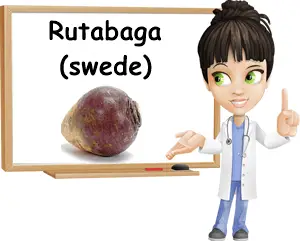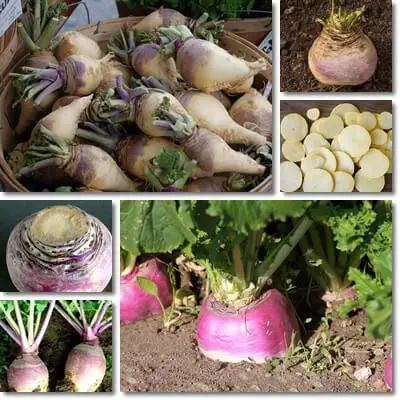What is rutabaga? Rutabaga is a root vegetable similar in appearance to a sturdier turnip. The name rutabaga comes from Swedish and means short, stumpy root, which is basically what rutabaga looks like. The vegetable is also called swede, from the Swedish name for turnip or neep and, in certain parts of the world, it is simply known as turnip. However, rutabaga is not actually a turnip, but rather a hybrid vegetable resulting from crossing a turnip with cabbage. And because the root of the plant is most often the part we eat, it’s known as a root vegetable, adding to the confusion between it and turnips.
Rutabaga is considered a winter vegetable because it is usually harvested in fall or right before winter and stored throughout winter in root cellars. It is often paired with other root vegetables like turnip, potatoes, celery root or celeriac, carrots, parsnip or kohlrabi. It’s not the most popular choice of a vegetable, yet remains a source of varied nutrition and significant health benefits.

Where does rutabaga come from? The reason why it’s called turnip in some parts of the world is because it’s very closely related to a turnip. Rutabaga is actually a cross between a turnip and a cabbage and is known under the scientific name Brassica oleracea var. napobrassica. You can tell it’s a cabbage family vegetable by its turnip-like appearance and aromatic profile, giving off a slightly pungent smell reminiscent of cruciferous vegetables. Rutabaga is believed to have been picked up for extensive cultivation as early as the 1600s when it was used both for human consumption and as livestock food.
What does rutabaga look like?
Rutabaga looks a lot like a white turnip, the turnip variety with white skin and a bit of purple towards the top. Except that rutabaga is more of a yellowish-brown in the lower half (hence the alternative name, yellow turnip) and a paler violet-purple towards the top. If the entire root is in the ground, covered away from sunlight, it may not develop a purple pigment almost at all and remain yellowish-brown or a dirty cream color all over. On the inside, the vegetable is an off white or light cream color, similar to celeriac or parsnip.
If left to mature, it grows to be so much larger than a turnip. A rutabaga can easily grow to the size of a small melon. The shape is rounded and slightly pointier towards the lower half. The entire vegetable looks like a thick, bulbous root with a more rough exterior compared to a turnip. Purple, white and green stems with dark green leaves sprout from the purplish upper part of rutabaga.
What does rutabaga taste like raw and cooked?
Raw rutabaga root is crisp, a bit juicy, slightly starchy and has a mildly bitter taste and faint sweet notes. Overall, the taste of rutabaga is similar to that of other cruciferous vegetables and you may discern a piquant cabbage scent, sweet, earthy celery notes or a faint bitter old turnip savor in the raw root. The older the root, the more bitter-tasting it can be; the more tender the root, the less bitter and more prevalent the sweet flavors. Although some older rutabagas can also be sweet rather than bitter, especially cooked.
Some people may perceive the taste of rutabaga as more bitter than others. This can be explained by the fact that the vegetable contains small amounts of bitter glucosinolates compounds which can be perceived by only a part of the population which has inherited the genes that allow them to recognize these bitter compounds. Although they are technically toxins, they have not been found to produce any side effects, provided intake of the vegetable is moderate.

Cooked rutabaga flavor is pleasant, with delicate sweet, earthy notes, almost no perceivable bitterness and a soft and smooth, almost creamy, rich texture. However, some people find cooked rutabaga a bit unexciting, somewhat bland, except maybe for its plain starchy taste and consider it works best heavily seasoned and enriched with butter or vegetable oils.
Both the bulbous root and green leaves of rutabaga are edible, although the root is clearly the preferred part, possibly because of its taste reminiscent of other root vegetables or potatoes. Cooked rutabaga tops or greens taste like slightly bitter, cooked greens. See Vegetables Page for more information on your favorite vegetables.
What is the difference between a rutabaga and a turnip?
The following differences may be observed:
1) Rutabagas grow bigger and are usually harvested at maturity, whilst turnips grow much smaller and are harvested preferably while still tender.
2) Rutabagas have a rough outer exterior, yellowish skin with brown smudges and paler purple top part, whilst turnips are white with brighter purple at the top and a smooth, finer skin.
3) A rutabaga has cream-colored flesh, while a turnip is whiter.
4) Older turnips are quite piquant to the taste, but rutabagas are more bitter than pungent.
5) Rutabagas are starchier, like potatoes; turnips are more piquant like radishes.
Rutabaga nutrition facts and health benefits
Including the root vegetable into your diet may provide the following nutrition and health benefits:
1) Low energetic value. 100 g of raw rutabaga has only 38 kcal. 100 g of boiled rutabaga has only 30 kcal, while 1 cup (170 g) of the boiled root has around 50 kcal. Such a low energetic value makes the root vegetable a good food for weight loss. Because it’s lower in calories than potatoes, it makes a great substitute for them especially in recipes such as mashed potatoes.
2) Good B vitamin profile. The root vegetable contains small amounts (less than 10% of the recommended daily value) of vitamins B1, B2, B3, B6 and B9 for every 100 g. B vitamins help the body process fats, carbohydrates and protein from food and convert them into energy. B vitamins further hold benefits for skin, muscles, brain and nervous system.
3) Mineral profile. The root contains small amounts of magnesium, manganese, potassium and phosphorus. Other trace minerals include calcium, iron, sodium and zinc, all under 10% of the recommended daily intake for an average adult. As a source of magnesium and potassium, rutabaga is good for high blood pressure and arrhythmia, although benefits are minor considering intake of the minerals is limited to less than 10% of the recommended daily intake. Manganese provides antioxidant benefits, while phosphorus is good for bones and teeth.
4) Good source of fiber. 100 g of raw rutabaga has 2.3 g of dietary fiber, while 100 g of boiled rutabaga has 1.8 g of dietary fiber. An average adult requires about 28 g of dietary fiber every day, so 100 g of raw root supplies about 8% of the recommended daily intake of fiber. As such, rutabaga root provides benefits for gastrointestinal health, regulating transit and preventing constipation. This, in turn, hold benefits for hemorrhoids. Also read Foods to Eat and to Avoid for Hemorrhoids. The fiber in rutabaga root also helps keep you full for longer, with possible benefits for weight loss. Finally, eating rutabaga root is good for better blood sugar levels, helping prevent spikes in blood sugar.
5) Rutabaga vitamin K content. Rutabaga root contains only 0.3 mcg (micrograms) of vitamin K. Compared to the recommended daily intake for an adult, which is 90-120 mcg a day, it’s clear the root has virtually no vitamin K. However, the greens are expected to have a generous content of vitamin K, similar to most other leafy greens like turnip tops, dandelion greens, mustard greens, beet greens etc. Rutabaga greens are also edible cooked and should have a high vitamin K content. However, if you have a predisposition for blood clotting or are receiving anticoagulant medication, talk to your doctor first before you eat greens rich in vitamin K.
6) Rutabaga vitamin C content. According to the United States Department of Agriculture (USDA), raw rutabaga root contains 25 mg of vitamin C for every 100 g. Vitamin C is a powerful anti-inflammatory nutrient with antioxidant properties, immune-boosting action and benefits for skin and joints. If you eat the root raw (without skin, of course), you may be getting between 25 and 30% of the minimum recommended daily intake of the vitamin. Cooking the root causes it to lose all of its vitamin C.
Energetic value: 38 kcal (kilocalories) or 157 kJ (kilojoules)
Water content: 89.43 g of water
Macronutrients:
Protein: 1.08 g
Fat: 0.16 g
Carbohydrates: 8.62 g
Fiber: 2.3 g
Sugars: 4.46 g
Micronutrients:
Vitamins:
Vitamin A: 0 mcg
Vitamin B1 (thiamin): 0.09 mg
Vitamin B2 (riboflavin): 0.04 mg
Vitamin B3 (niacin): 0.7 mg
Vitamin B6 (pyridoxine): 0.1 mg
Vitamin B9 (folate): 21 mcg
Choline: 14 mg
Vitamin C: 25 mg
Vitamin D: 0 mcg
Vitamin E: 0.3 mg (you need 15 mg a day)
Vitamin K (root): 0.3 mcg (you need 90-120 mcg a day)
Vitamin K (leaves): content not calculated, but estimated to be high
Minerals:
Calcium: 43 mg
Iron: 0.44 mg
Magnesium: 20 mg
Manganese: 0.130 mg
Phosphorus: 53 mg
Potassium: 305 mg
Sodium: 12 mg
Zinc: 0.24 mg
Rutabaga preparation for cooking
It’s relatively easy to prepare a rutabaga for cooking.
How to peel rutabaga. Using a sharp peeler, you carefully remove the vegetable skin and discard it. Store-bought rutabaga may have a layer of wax applied to the skin which should make peeling relatively easy.
How to cook rutabaga. Like you would any other root vegetable. It can be eaten raw, boiled, roasted, baked or fried. Ideally, it should be started in cold water when boiling. It can be chopped, pureed or sliced, cooked alone or mixed with other root vegetables.
Rutabaga recipe ideas
The best recipe to start with is plain rutabaga puree, seasoned with salt, a bit of pepper, cold pressed extravirgin olive oil or a little butter and milk. Another good recipe if you have never eaten rutabaga is to peel and cut the root into fries or sticks (or slice it), coat with oil and season to your liking (salt, pepper, garlic, nutmeg, rosemary or other herbs), then roast in the oven until golden and delicious (should take 40-45 minutes at most). You can roast a whole rutabaga root too. One of my favorite recipes is boiled chicken or beef with a mix of boiled root vegetables (rutabaga, carrots, parsnip, turnip, potatoes and celery – make sure you are not allergic). You can even make a delicious oven roast with meat and different kind of root vegetables. You can incorporate rutabaga in stews, casseroles or bake in a meat and vegetable pie.
So are rutabagas good for you?
Eating rutabaga is good for you because it provides relatively good nutrition. While it may not be as nutritionally dense as eggs, dairy, leafy greens, nuts, seeds or some fruit, the root vegetable boasts a varied nutritional profile, containing B vitamins and important minerals such as magnesium and potassium, phosphorus and manganese. Its lower carbohydrate content and energetic value compared to potatoes makes it a good replacement for anyone looking to reduce their carbohydrate intake and lose weight. Rutabaga adds variety to any diet as a moderately nutritious food.
